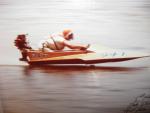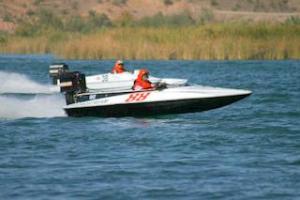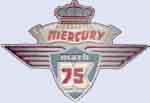From a pure theoretical aspect the thrust provided by a propellor pushing a fluid (water or air) per the momentum theory is related to
Thrust = mass flow rate thru propellor x Velocity
More specifically the variables are: density of the fluid, the area of the propellor disk and the square of the change in velocity (acceleration) of the fluid thru the propellor or:
Thrust = Ct x ro x area x (Vj^2 -V^2)
Ct = thrust coefficient, via experiment
ro = density, esentially constant for water but very variable for air
Vj = velocity of water jet exiting the prop i.e the water we see going
backwards from the prop. Note low roostertails = more thrust
V = velocity of boat, opposite Vj
Since area = pi/4 x D^2
D = diameter
Then
Thrust = Ct x ro x pi/4 x D^2 x (Vj^2 -V^2)
Note V and Vj are related to propellor rpm = engine rpm/ gear ratio
Also note that the thrust is a max when the boat is not moving or pushing at max rpm and not going forward. Also as the boat speed increases the thrust decreases and at max speed the thrust is exactly equal to all the drag.
Thrust is very sensitve to diameter and velocity change since they are related as the square. Thus if all else remains the same and the diameter was decreased by say 1" on a 10" prop that would result in a relative thrust change of (9/10)^2 = 0.81 or a 19% reduction. However this assumes that there is no change in Vj and V the velocity change thru the prop and for a diameter reduction there would be changes in the velocity thru the prop.
There are many variables and thus the analysis is quite complex especially when surface piercing propellors are considered.
Here is an interesting analysis I found for a jet ski. The same principles apply in that the water jet moving backward is an anology to the prop moving the water backward.
http://greenhulk.net/forums/showthre...=thrust+output
Here is a text by Dave Greer on propellors that has some usefull insight
http://books.google.com/books?id=8w0...snum=9#PPP1,M1


 Thanks:
Thanks:  Likes:
Likes: 





 Reply With Quote
Reply With Quote !! You hit the nail on the head. Very interesting and informative read.
!! You hit the nail on the head. Very interesting and informative read.





Bookmarks